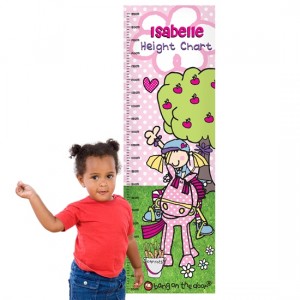Height Chart For Kids
December 28, 2012 by Jordan Morgan
Filed under Family and Personal
Personalised wooden height chart come in a range of fun designs, your child will love getting measured regularly to see how much they’ve grown.
Not just a measure of how tall your child has grown, our height chart and growth charts are a colourful, fun addition to any child’s room.
Children grow so fast! These personalised height charts are a lovely way to chart your child’s growth and make fabulous gift ideas.
A brilliant way to accessories a kids’ bedroom and a lovely keepsake that you can look back at in disbelief when your little ones are fully grown.
Measuring Height Accurately At Home With Height Chart
To measure height accurately at home to calculate BMI-for-age:
Remove the child’s shoes, bulky clothing, and hair ornaments, and unbraid hair that interferes with the measurement.
Take the height measurement on flooring that is not carpeted and against a flat surface such as a wall with no molding.
Have the child stand with feet flat, together, and against the wall. Make sure legs are straight, arms are at sides, and shoulders are level.
Make sure the child is looking straight ahead and that the line of sight is parallel with the floor.
Take the measurement while the child stands with head, shoulders, buttocks, and heels touching the flat surface (wall). (See illustration.) Depending on the overall body shape of the child, all points may not touch the wall.
Use a flat headpiece to form a right angle with the wall and lower the headpiece until it firmly touches the crown of the head.
Make sure the measurer’s eyes are at the same level as the headpiece.
Lightly mark where the bottom of the headpiece meets the wall. Then, use a metal tape to measure from the base on the floor to the marked measurement on the wall to get the height measurement.
Accurately record the height to the nearest 1/8th inch or 0.1 centimetre.
What influences growth
During childhood: Both weight gain and increases in height come in short bursts of what can seem like rapid growth — which is why kids can sometimes look almost chubby one month but lean the next. The duration of a growth spurt, as well as how much a child grows during one, differs from child to child (and from spurt to spurt in the same child). But it’s not uncommon to see a visible difference in a very short time:
No one knows what causes a kid to shoot up one month and not another, but there does seem to be a seasonal pattern. “Although we don’t have a good explanation for it, children seem to grow fastest in the summer and slowest in the fall.”
Doctors do know what triggers growth in the first place: It’s the human growth hormone, a chemical produced in bursts throughout the day but released largely during sleep. That’s why it’s important for kids to get the shut-eye they need throughout childhood and adolescence.
During puberty: After infancy, the tween and teen years are the period of most rapid change. For girls, the growth spurt begins between 10 and 11 and lasts until around 15; for boys, it starts about two years later and lasts until age 17 or so. Girls typically stop growing about three years after they’ve had their first period, but boys continue to grow throughout their teens you will be able to measure this with a height chart.

